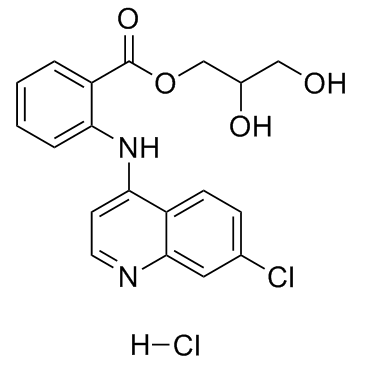Glafenine hydrochloride (Glafenin hydrochloride) |
| Catalog No.GC31681 |
Glafenine hydrochloride (Glafenin hydrochloride) is a non-narcotic analgesic and non-steroidal anti-inflammatory drug.
Products are for research use only. Not for human use. We do not sell to patients.

Cas No.: 65513-72-6
Sample solution is provided at 25 µL, 10mM.
Glafenine hydrochloride is a non-narcotic analgesic and non-steroidal anti-inflammatory drug. It is an ABCG2 inhibitor with an IC50 of 3.2 μM.
Glafenine increases the surface expressionof mutant CFTR in baby hamster kidney (BHK) cells to 40% of that observed for wild-type CFTR[2]. Glafenine hydrochloride inhibits the proliferation and clonogenic activity of haSMCs and ECs in a dose-dependent manner. A block in the G2/M phase and a reduction in the G1 phase occurr. The migratory ability of haSMCs is impaired in a dose-dependent manner and the extracellular matrix protein tenascin is reduced[3].
Glafenine injection (25 mg/kg i.v.) shows enhanced BLI signal in mice with an average of 2.9-fold signal enhancement over the control. Glafenine causes increases in BLI signal of up to 11.6- and 17.4-fold in two separate HEK293/ABCG2/fLuc xenografts in the same mouse compared to the signals generated by those xenografts immediately before injection[1]. Incubating polarized CFBE41o- monolayers and intestines isolated from mutant CFTR mice with glafenine increases the short-circuit current response to forskolin and genistein. Treatment with glafenine also partially restores total salivary secretion[2]. Glafenine-treated zebrafish shows evidence of endoplasmic reticulum and mitochondrial stress, with disrupted intestinal architecture and halted cell stress responses, alongside accumulation of apoptotic intestinal epithelial cells in the lumen[4].
[1]. Zhang Y, et al. Identification of inhibitors of ABCG2 by a bioluminescence imaging-based high-throughput assay. Cancer Res. 2009 Jul 15;69(14):5867-75. [2]. Robert R, et al. Correction of the Delta phe508 cystic fibrosis transmembrane conductance regulator trafficking defect by the bioavailable compound glafenine. Mol Pharmacol. 2010 Jun;77(6):922-30. [3]. Sch?ber W, et al. Impact of glafenine hydrochloride on human endothelial cells and human vascular smooth muscle cells: a substance reducing proliferation, migration and extracellular matrix synthesis. Cell Biol Int. 2003;27(12):987-96. [4]. Goldsmith JR, et al. Glafenine-induced intestinal injury in zebrafish is ameliorated by μ-opioid signaling via enhancement of Atf6-dependent cellular stress responses. Dis Model Mech. 2013 Jan;6(1):146-59.
Average Rating: 5 (Based on Reviews and 1 reference(s) in Google Scholar.)
GLPBIO products are for RESEARCH USE ONLY. Please make sure your review or question is research based.
Required fields are marked with *




















